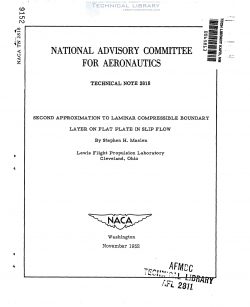naca-tn-2818
- Version
- 135 Downloads
- 1.01 MB File Size
- 1 File Count
- January 17, 2017 Create Date
- January 17, 2017 Last Updated
National Advisory Committee for Aeronautics, Technical Notes - Second Approximation to Laminar Compressible Boundary Layer on Flat Plate in Slip Flow

The first-order solution for the laminar compressible boundary-layer
flow over a flat plate at constant wall temperature is given. The
effect of slip at the wall as well as the interaction between the
boundary-layer flow and the outer stream flow are taken into considera-
tion. The solution is obtained explicitly in terms of the known zero
order, or continuum, solution. No assumptions regarding the Prandtl numr
her or viscosity-temperature law need be made. It is found that the
first-order solution gives a decrease in heat transfer and, for super-
sonic flow, an increase in skin friction. For subsonic flow there is no
first-order shear effect. The change in heat transfer is due to slip
and the change in friction is due to the interaction of the zero- and
first-order velocities at the outer edge of the boundary layer.
With very high-altitude high-speed motion becoming of practical
interest, the behavior of air flow in rarefied and semirarefied gases
becomes of great importance. In this connection, as has been discussed
by Tsien (reference 1), one can define four regimes of fluid flow.
These may be termed, in order of increasing mean free path of the fluid
molecule: continuum, slip, intermediate, and free molecule flows.
Continuum flow, where the mean free path of the fluid is negligible com-
pared with the boundary—layer thickness, has been exhaustively studied
for some time, while the other regimes have not. These latter domains
differ from the continuum flow both in the form of the equations of
motion and in the boundary conditions. The change in the boundary con-
ditions appears in the form of temperature and velocity discontinuities
between a solid boundary and the fluid immediately adjacent to it.
The slip regime may be loosely defined to include flows such that
the ratio of mean free path to boundary—layer thickness (which is shown
in reference 1 to be proportional to the Mach number divided by the
square root of the Reynolds number) is between 0.01 and 1. It may be
noted that this Parameter is the Knudsen number based on boundary-layer
thickness. In this regime the flow may be defined by the Burnett equa-
tions (references 2 and 5), which represent the second approximation to
the Boltzman equation, the first approximation being the familiar
Navier-Stokes and energy equations.
| File | Action |
|---|---|
| naca-tn-2818 Second Approximation to Laminar Compressible Boundary Layer on Flat Plate in Slip Flow.pdf | Download |
Comment On This Post